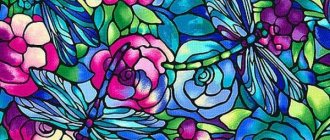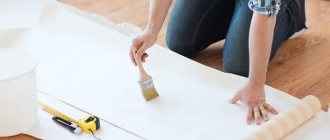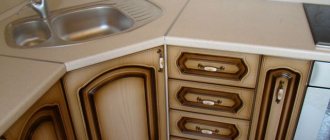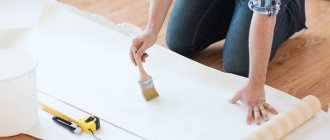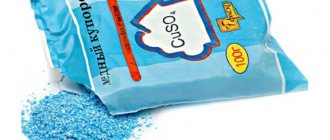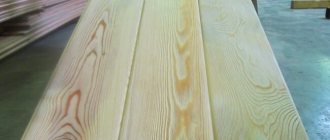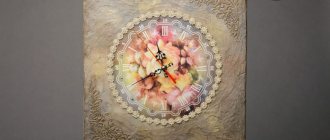Stained glass painting is a type of art that has not yet lost its relevance. Stained glass windows were used to decorate temples, palaces and castles. Previously, only noble people could afford such decoration. And even now, stained glass drawings are not affordable for everyone. At first they decorated church buildings, then survived the Renaissance and filled the houses of wealthy citizens, and now they are found not only on houses, but also in miniature accessories.
Stained glass is a way of decorating glass and mirrors.
What is stained glass drawing
Modern painting is the process of applying paint to glass or ceramics. Craftsmen of past centuries were content with colored glass. From many pieces of glass they laid out biblical scenes and picturesque paintings. The principle of fine art was similar to mosaic. By transmitting sunlight, the glass “forced” the window or wall picture to play with new colors.
Now stained glass paintings are very popular in the creation and design of interiors.
In the 21st century, art made it possible to create decorative items that were exclusive of their kind. Stained glass decorates:
- mirror;
- interior door;
- window;
- household items;
- table services;
- paintings;
- wall panel;
- interior partitions;
- decorative inserts in wall panels;
- ladies' jewelry and more.
The advantage of the technology is the ability to create stained glass yourself.
This type of design continues to fascinate with its originality and play of reflections. Thanks to emerging technologies, there is now no need to collect a drawing bit by bit. The painstaking work of creating glass mosaics has turned into a fine art. To apply the image you will need special stencils and paints for stained glass painting. The picture for stained glass on glass can be printed on a printer.
The main thing is to choose the right pattern and not be afraid to look for extraordinary ways in creativity.
Types of stained glass designs
Popular topics include the following types:
- Abstraction looks beautiful as a panel on an elongated surface or on glass of a non-standard shape.
- It is better to depict nature on rectangular and square glass. Landscape paintings will decorate the hall and living room.
- Pictures in the Art Nouveau style are suitable for decorating any living space.
- Gothic patterns are distinguished by the angularity of their details. The figures of people, birds and animals are made in the style of the Middle Ages. They look beautiful on round, oval and arched shapes.
- Antique stained glass will appeal to lovers of the classics. He combined portrait subjects, floral arrangements and intricate mosaics.
Medieval Europe - the beginning of the journey
Initially, glass paintings found their application in religious buildings. The central images here are the figures of Jesus, the Virgin Mary, saints, monarchs, biblical scenes, etc. And the artistic design of these figures was carried out using various patterns that formed the background of the works and framed them around the perimeter. There are several variants of ornaments in stained glass art of this period:
- Framing the work. In this product, there is a decorative frame filled with one or another pattern. For example, the cathedral in Bourges is decorated with a canvas depicting the parable of the prodigal son. This plot is enclosed in a frame with a twisted ornament, the basis of which is cross-shaped plant elements. Blue, green and white colors on burgundy look symbolic, the image is laconic.
- Background for the plot. Often the figures were placed against a background of transparent, colorless glass, but when colored glass was used, the background also had to be decorated artistically. This is how the craftsmen worked, decorating the upper tier of the choir of the cathedral in Evry. The entire visual effect is based on variations and alternations of rhombuses. Some saints are depicted against a background of deep blue diamond patterns, while others use burgundy diamonds as the basis. In the latter case, the composition is complicated by small turquoise circles-drops at the corners of these figures. This emphasis adds variety to both the composition and the color of the work, and enlivens it.
- The basis of the entire composition. Very often, the biblical scenes themselves on stained glass windows were arranged within large floral or geometric patterns that formed the basis of the window frame. A striking example of this is the famous roses in the Cathedral of Notre Dame de Paris. Round windows, radii divided into many segments associated with petals, look like complex and intricate flowers. And in each segment there are stained glass canvases depicting certain plot scenes.
Specialists from the Steklosfera studio remind us that all three types of ornamental filling were often found on the same product. The most common motifs in Medieval Europe are the following: fleur-de-lis, oak leaves, crosses of various modifications, rectangles, twisted arcs, rhombuses, circles, etc. In general, we can conclude that geometric motifs dominated in the ornaments.
What type of painting is better to choose?
The theme for the picture is chosen according to your taste. Most often they depict landscapes, bouquets of flowers, birds and animals. The main difference between the patterns is the technique of their application. There are several stained glass painting techniques:
- contour;
- without contour;
- multilayer;
- spot.
Decorating traditions are often used in furniture design.
Each type of painting allows you to create an original work.
Contour
The contour technique uses a sketch, which is a black and white drawing with clearly drawn contours. The voids between the contours are filled with paints to result in a beautiful ensemble. The main advantage of the technique is the ability to see the “draft” version of the picture in advance. Even a beginner can do the drawing.
It is this type of stained glass that is most popular today; they are created on mirrors or glass.
Contourless
Contourless technology is not particularly popular among ordinary people. At the end of the work, the picture does not have clear contours or transitions. It resembles a typical watercolor only with a varnish coating. The highlight of the non-contour pattern is the random mixing of colors. This type of pattern is much more complex than the previous one. It will take you a lot of time and effort to master the contourless technique.
It is best to use stained glass varnish paints to create beautiful paintings using the contourless technique.
Multilayer
Multilayer technique fully lives up to its name. This type of paint application allows you to create the most realistic paintings. Layering one layer on top of another can be done in a “dry” or “wet” way. In the first case, the bottom layer is allowed to dry thoroughly, and in the second, the previous layer is mixed with the new one, without allowing it to harden. Using multi-layered drawing you can convey shadows and play of light. This technique does not tolerate amateurs. Only a professional stained glass master can handle it.
Multilayer etching is carried out with special compounds in several layers.
Spot
Spot painting is one of the widely used but labor-intensive types. It is used to decorate not only glass, but literally everything, from book covers to clothing. The technique involves spot-applying paint to the surface. The dots differ in color, saturation and size.
Spot painting on glass looks very bright and original.
Stencil
If the listed techniques require artistic taste and the ability to draw, then the stencil method of painting is a godsend for pioneers in stained glass painting. The stencil will allow you to paint the surface evenly and accurately. It can be disposable or reusable. The first is made of paper or thick cardboard, and the second is made of self-adhesive polymer film.
Thanks to the availability of various stained glass paints and interesting stencils, anyone can master this art.
Stencils can be purchased at stores that sell art supplies. You can also print them on a printer or draw them yourself. The disadvantage of stencil painting is the taboo on exclusivity. But if desired, this minus can be reduced to nothing. The main thing is to show your imagination and collect individual elements into a single composition.
Using stencils you can create spectacular glass painting.
Is it possible to draw a stained glass window with a pencil?
To work, you just need to stock up on bright colored pencils, paper and an eraser. On the surface you need to draw a sketch using “broken” shapes, as if the picture was really made of soldered pieces of glass. Color the details with colored pencils. You can highlight the borders using a black marker, felt-tip pen or paint (watercolor, gouache). Also try making a frame using thick cardboard, paper and PVA glue.
What materials are needed for stained glass painting
Before you start painting, you need to buy special materials and decide on the location of the painting. These include the following accessories:
- basic paints;
- contour paints;
- brushes of different thicknesses with artificial bristles;
- acrylic clear varnish;
- stencil;
- alcohol;
- synthetic solvent;
- Double-sided tape.
Materials you will need to create your own stained glass window.
Auxiliary items include napkins, pieces of fabric, cotton swabs and toothpicks. With their help it will be possible to remove defects in the drawing.
Painted stained glass windows are the easiest to create. Even children can make such stained glass.
Important! Paints are divided into two types: for firing and not requiring firing. For beginners, it is better to choose those that do not require heat treatment.
Surface and stencil preparation
Procedure:
- First, wash the surface of the glass with water and detergent, then degrease it with alcohol and let it dry completely.
- While the surface dries, secure the stencil with double-sided tape. Then press it firmly onto the surface and smooth it out well.
- Take contour paints and outline the outline of the stencil.
- Then fill the voids between the contours with paint.
- Dry the surface well. You can leave the product for several hours or a day. Drying time depends on the type of paint.
- Once completely dry, coat the image with clear acrylic varnish.
Painted stained glass does not require special equipment or complex manufacturing technology.
Note! When applied, the paint has a dense and opaque consistency. You can tell whether it has dried or not by its appearance. After drying, it becomes transparent and transmits light well.
Stained glass windows in the Tiffany style are distinguished by grace and lightness.
For stained glass painting, not only stencils are used, but also templates. In the first case, there is no need to outline the drawing, but in the second, the outline is applied manually. The template resembles a carbon copy of a pattern.
Fusing is an original type of stained glass. The technology consists of soldering individual elements together in a fusing furnace.
How to draw your first stained glass window
Use a step-by-step action plan:
- select the theme of the picture;
- prepare a sketch template and necessary materials;
- choose a well-lit and ventilated room;
- place the glass in a horizontal position;
- place the template under glass;
- degrease the working surface with alcohol;
- carefully trace the outline according to the template;
- let the paint dry naturally or use a hair dryer;
- then take colored paint and gradually fill the voids between the outline;
- Apply the paint carefully and try to paint evenly without overstepping the outline.
A stained glass window that conveys a landscape or painting is well suited to a modern interior.
Advice! Despite the fluidity of stained glass paint, it does not have time to spread evenly across the glass. It will take skill to get a neat job. Make sure that there are no air bubbles or gaps between the outline and the base color.
It is worth choosing light designs for stained glass with one main element and small additions along the periphery.
Simple step-by-step instructions
Cut the colored material into small pieces. The outline can be made using thicker paper or thin rolled napkins. To make stained glass look natural, try cutting out a template from thick cardboard.
- Step 1. Take the template, turn it over and coat it generously with glue. You can use regular PVA and a thin brush.
- Step 2. Glue cut pieces of colored paper onto the template. Choose the order of the shades according to your personal preference.
- Step 3. Let the stained glass dry, and then stick it to the glass using glue or double-sided tape.
- Step 4. Have you decided to remove the finished template? Use a rubber scraper and acetone to remove any remaining adhesive from the glass surface.
Samples of stained glass painting
For a sample of stained glass painting on glass, choose templates with the pattern you like. When deciding to diversify your interior with stained glass, consider the following tips:
- the drawing should suit the general style of the apartment;
- the lines and colors of the pattern can conceal and visually expand the space;
- too bright paintings overload the room.
Stained glass is unthinkable without light, so the ability of glass to diffuse light, but not absorb it, allows you to create unusual color schemes in the interior.
The plot can be of any topic. Most often it is done in an abstract style, with a plant motif or strict geometric shapes, in the form of a still life or landscape. An abstract picture is the best option for a modern interior. But for lovers of the classics, it’s better to choose nature. Landscape paintings will become an outlet for household members.
Stained glass windows in the interior of an apartment or house are present in many photographs of the works of modern designers, so choosing a suitable design will not be a problem.
Stained glass painting is a great idea for decorating interiors, windows, interior doors, mirrors and glass sets. It takes time and patience to create a masterpiece. But the first stained glass designs can be obtained using ready-made stencils and templates.
A wide selection of stained glass options allows a person, even with a small income, to give his home exquisite beauty and originality.
Preamble
In the Middle Ages, plain glass, not to mention colored glass, was an expensive product. Even an ordinary person could not afford it, preferring to decorate their houses with wooden shutters. The stained glass window itself was religious in nature. Geometric patterns, which were seen as a representation of the perfection of God, were especially popular. And such glass greatly transformed the holy place, creating a unique atmosphere.
Today, stained glass windows are simply a beautiful decoration that can be found in any secular home. The right tools and materials, patience and desire will help you create unique colored glass yourself.


